If we didn’t have enough hurdles to electric vehicle adoption in the US, one of the challenges that drives me absolutely bonkers is the confusing and inconsistent use of charging terminology. And this starts with the term “charging station”.
Engineers — bless their souls — love to use technical terms, acronyms, and correct you when you use a term that is easy for consumers to understand, but not technically correct. In the EV industry the poster child of this is the term “charger.” Any engineer worth a kilowatt will correct you faster than you can say J1772 that the charger is actually onboard the electric vehicle and is not to be confused with the external power source.
True. But nobody else cares.
What Does “Charging Station” Mean to You?
To scale up EV adoption we need to increase consumer awareness and understanding of the “electric refueling” process. This requires simple, easy-to-understand terms without jargon, and that leverage consumer’s existing reference point of the gasoline refueling experience.
Beyond the use of confusing, technical and jargony terms and acronyms, a foundational communications problem with EV charging is that the industry doesn’t even agree on what the most basic of terms — EV “charging station” — actually refers to.
Below is a simple and typical example of the confusing and inconsistent use of the term “charging station” from a news article shared on Twitter. In an ensuing discussion around this “charging station” reference it wasn’t clear what the author meant. None of us were certain whether “charging station” referred to the site or location as in the analogous gas station? Or did “charging station” refer to the individual charging hardware – even more confusingly referred to as port, hardware, EVSE, pedestal, and several other terms.
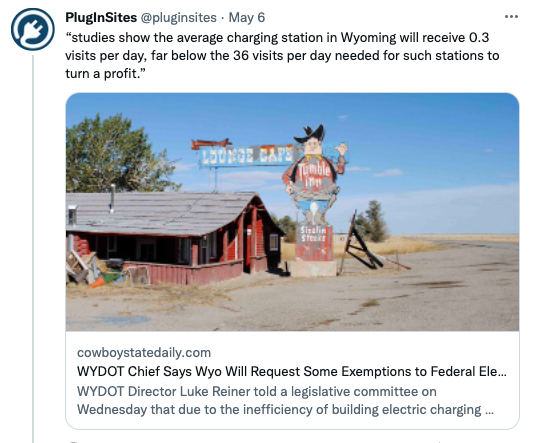
Charging Station Twitter Poll
To attempt to shine a light on this confusion and inconsistent usage, I conducted a simple and very unscientific poll on Twitter. While only 118 responses among knowledgeable EV folks on Twitter, the term “charging station” was nearly equally split on what the term meant. 39% assumed charging station refers to the site/location and 43.2% believe it means the individual connection / charger / port / hardware. Nearly 18% felt it could have either meaning (which in hindsight was not a meaningful option for this poll question).
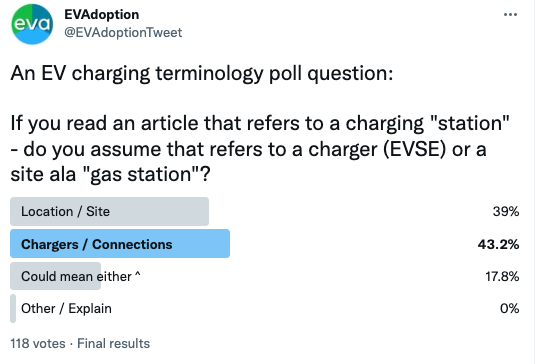
But this close split in interpretation of the term “charging station” is exactly what I expected. Depending on the person, each of us brings different backgrounds and context to this phrase creating confusion and a lack of clarity in the market.
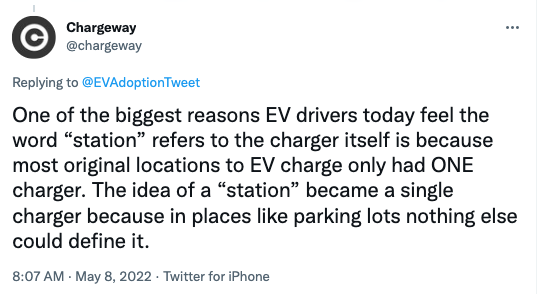
So What’s The Big Deal?
So why does it matter if for some people the term charging station refers to the site or location and to others it means the actual charging hardware?
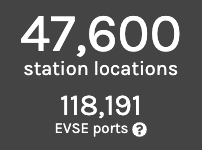
For one, clarity and consistency is critical for sharing statistics and making comparisons. When an article says there are something like 115,000 charging stations in America less than the estimated ~145,000 fueling stations, it’s important to get this right. First, according to the AFDC database, as of May 15, 2022 there were 47,600 Level 2 and DC fast charging locations with more than 118,00 ports (charging connections – this language is yet another issue). Because some of the charging networks such as ChargePoint actually report each individual charger as a “location,” this number is actually lower than the 47,600.
Secondly, most modern sites that sell gasoline (convenience stores, gas stations, warehouse stores like CostCo and Sam’s Club, supermarkets like Safeway) may have from 12 to 20 individual pumps. So a more accurate approach is to compare the 118,000 ports to say 17.4 million (12 times 145,000) estimated gas pumps.
Charging Station Versus Gas Station: Comparing Apples to Oranges
Well actually no. If we are going to make comparisons between EV charging and gas station infrastructure then we need to at least compare apples to apples. But therein lies the second and third problems. This comparison ignores the fact that a majority of EV drivers primarily charge at private locations (where they live or work) and not public charging locations. In the roughly 2,000 days we have driven EVs we have only used public charging about an estimated 35 times. And most of that was during about 5 road trips to and from Southern California.
The third problem in this apples to oranges comparison is that there are roughly 280 million gas vehicles on the road versus about 2.5 million EVs (including PHEVs). So there are about 16 ICE vehicles to every gas pump versus 21 Level 2 and DC fast chargers to each BEV and PHEV. And then if we assume that 70% of EV owners have access to charging where they live, then the ratio for EVs to EV chargers is actually 1.3 to 1.
But I digress. That exercise in numbers and ratios of gas pumps and EV chargers was simply meant to bring to life why getting EV charging terminology defined simply, clearly, and with the same meaning is critical. Without this we cannot have meaningful and accurate conversations about the state of EV charging infrastructure.
Alternative Fueling Station Locator Definitions of Charging Infrastructure Terminology
Below is a diagram from AFDC that defines their use of terminology. And from a technical perspective this makes sense. For statistical comparison sake and accuracy, differentiating terms and definitions for a port versus a connector is important.
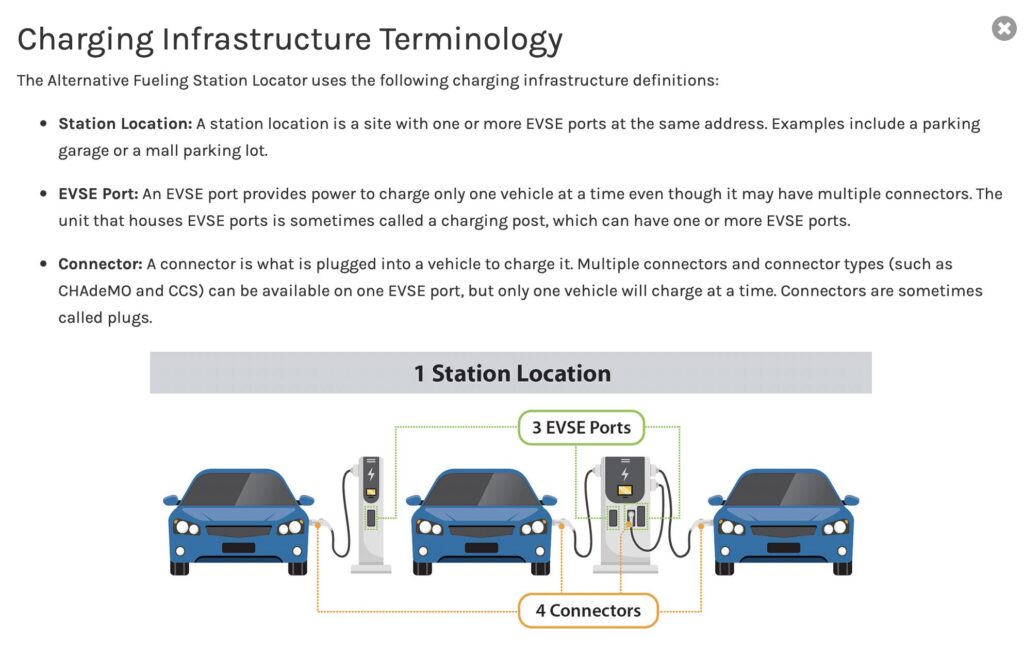
Time Is Now For The EV Industry To Have Standardize Terms Like Charging Station
But from a consumer awareness and education perspective, we need to agree on standardized and simple terms. We have a choice. We can use technical and complicated terms that require consumers to have to think and learn new concepts. Or we can tap into their existing understanding of the refueling process and make it easy for them to grasp “electric refueling.”
My friend Matt Teske, founder and CEO of Chargeway, whose background was in brand and design, has long advocated for a simple approach of using Station > Charger > Plug. With the idea being that “station” is the same whether gas or electric in that it refers to the refueling site or location.
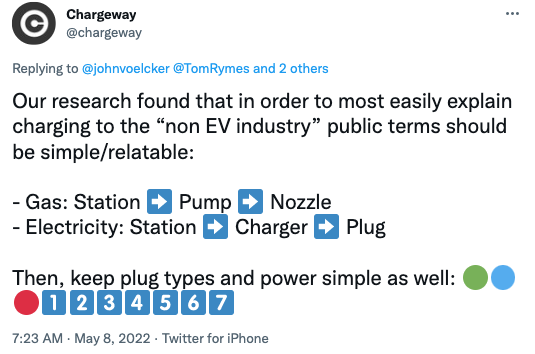
“Charger” then refers to the charging hardware/post/pedestal/dispenser/port which is akin to a gas “pump.” And then the term “plug” (the connector that is compatible with your EV and plugs into your EV’s charging receptacle) equates to the gas “nozzle.”
Whether Matt’s terms are the best ones for the industry to use and standardize around is irrelevant for the moment. Our first goal as an industry is simply to gain agreement that we have a problem. And if we are going to make it easy for mainstream consumers to feel comfortable switching to an EV — then we must use simple, consumer-friendly terms that mean the same thing to everyone.
If you would like to help launch an industry initiative to standardize terms or have suggestions on existing groups best positioned to lead this effort, please reach out.

